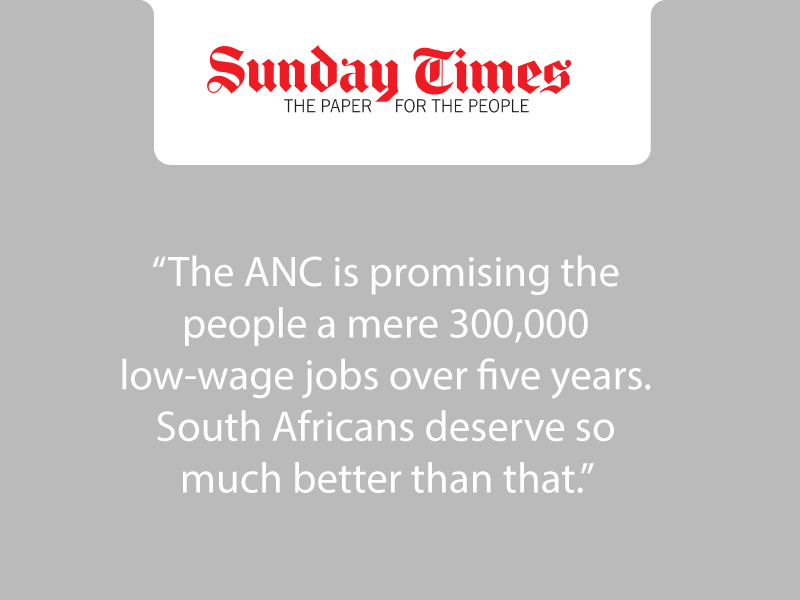
South Africans are loose in the way they use statistics and factual information. It is a dangerous habit.
For example, in 1988 on behalf of the Urban Foundation, we estimated that 7-million people lived in informal circumstances. This was a very rough ballpark figure. Yet, to this day, that figure is still quoted by most politicians, officials and the media as the country’s squatter population. No one has thought to question whether the population might have grown in the past seven years! Another example is the ever-changing figure for the population of Soweto. No one knows for sure, and this seems to give anyone who cares license to invent whatever number suits their purpose.
In 1989 the Urban Foundation provided the country’s most comprehensive assessment of national demographic and income trends available at that time. The key message of this work was twofold: the failure of apartheid in urban and rural SA and the importance of focusing on the country’s growing cities as the centres of national economic growth and development.
The Centre for Development and Enterprise (CDE) has just completed a major new study of the country’s demographic and income trends, based on a second and updated edition of the foundation’s earlier demographic and income distribution models. The 1995 study is the only integrated and comprehensive analysis of recent population and income trends.
This means that if you say the population of Cape Town is growing by about 10 000 people a month, for this claim to have credibility you need also to explain where these people are coming from (eg the Ciskei) and more importantly demonstrate that studies there show a diminution of that rural population. Statistics that neglect this are unreliable.
Some important findings and conclusions emerge from the study. A new SA geography is emerging in terms of which urban and rural areas can be thought about in more rational terms. The CDE work classifies the population into those who live in metropolitan areas (places of more than 500 000 people of which there are eight in the country); cities/large towns (60 000-500 000 people in 45 places); small towns (1 000-50 000 citizens in 278 different towns); and rural areas.
Although it is useful to impose this rational classification on SA’s apartheid landscape, it is important not to ignore the anomalies of our racial legacy. Botshabelo, about 50km outside Bloemfontein, is one example of this. It is not part of the Bloemfontein urban area and has been excluded from their local government structures. It would be misleading to call it a town, as it is an apartheid creation where people were dumped in the middle of the veldt. There is no real economic base and virtually no community facilities. Initially it was officially classified ‘non-urban’; the 1991 census now regards it as urban. Neither classification would seem to reflect its status accurately. Similar difficulties exist in other areas. What about the densely settled parts of what used to be KwaNdebele from which many residents commute to work in different parts of Gauteng?
One thing is certain: many people, and probably the majority classified as rural, have no connection at all with agricultural production. We need to know about these densely settled ‘apartheid-created’ communities. The next census needs to use a classification which will make their situation more visible. Above all we need to ensure that ‘apartheid’s hidden urbanites’ are not ignored in the policies and programmes of the government.
All our figures come with an important warning attached. There are large and important areas of ignorance and uncertainty concerning SA demographics. There are no reliable statistics (and do not believe anyone who claims there are) concerning the scale of illegal immigration; and the pattern and rate of internal migration. In addition, the base of all our models is the 1991 census. Although this census was better in some respects than earlier surveys, insufficient resources were devoted to capturing new and complex dynamics of an expanded population. However, to reject the census altogether is to plunge the country and decision makers into the realm of pure speculation and with all the faults the census data is better than nothing. At minimum, the CDE models will need to be tested as new data becomes available.
The analysis shows that population projections for the country as a whole are lower than those made before 1992. Earlier estimates for 2010 were 59,7-million. Our new estimate is 53,4-million. One of the reasons for the lower projection is that black fertility has dropped more rapidly than was expected – an equivalent decline in fertility in a shorter period than it took whites. The notion that black people have more permanent ‘cultural’ predisposition towards large families is patently wrong.
In line with this will be 5-million fewer people in the metropolitan areas by 2000 than previously forecast. Nonetheless the greatest share of the country’s population increase is still expected to occur in the metropolitan areas, and the study forecasts there will be 7-million people in metropolitan areas in 15 years time. This will have enormous consequences for how we plan, and govern our cities.
The new study shows that previous work seriously underestimated the population growth and potential of SA’s intermediate cities and large towns. Population growth rates between 1981 and 1991 for this category were almost twice that of the metropolitan areas. This is an area of opportunity for the country. This finding also dispels the notion that ‘everyone is coming to the PWV (Gauteng) region.
With respect to income data, CDE finds that between 1985 and 1995 average per capita income rose for all population groups except whites, who suffered a small decline. This translates into a gradual and widely spread improvement in black living standards despite the drop in real per capita income for the country as a whole. The proportion of households in poverty dropped between 1985 and 1990 but rose slightly between 1990 and 1995 because of very poor performance between 1989 and 1993. It is clear that economic growth is the key ingredient (necessary but not sufficient) in tackling national poverty.
The pattern of poverty is much the same today as it was in 1983 – 94% of all poor households were black and 64% lived in small towns or remote rural areas. However, this does not mean urban poverty should be ignored. There is substantial, potentially explosive, urban poverty.
On the basis of its work, CDE would make the following recommendations to the government.
- First, it should recognise and publicly acknowledge the problem of SA’s inadequate demographic and income statistics.
- Second, it should formulate a strategy to redress this situation where no one knows for sure the scale and nature of the challenges we face.
- Third, when in doubt about development needs, do not rely on existing macro-demographic and official statistics, but conduct new studies.
- Fourth, revise the system of designing and undertaking censuses in SA. This should not be done by central government alone. Partnerships are required with other levels of government, with the private sector and with communities.
- Finally, establish a computer based information system accessible to all citizens and tiers of government.
- National statistics should not be influenced by political ideology (their interpretation might be but that is a different matter) and this means that the independence and analytic rigour of the national information and data collection system has to be assured.
Ann Bernstein, Business Day




